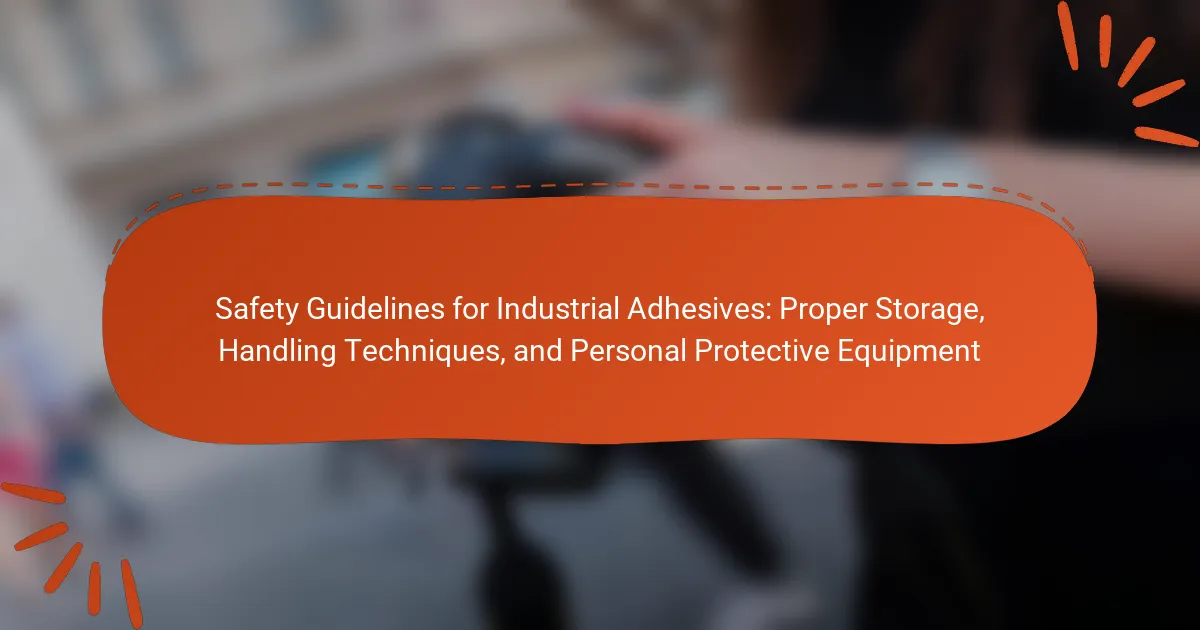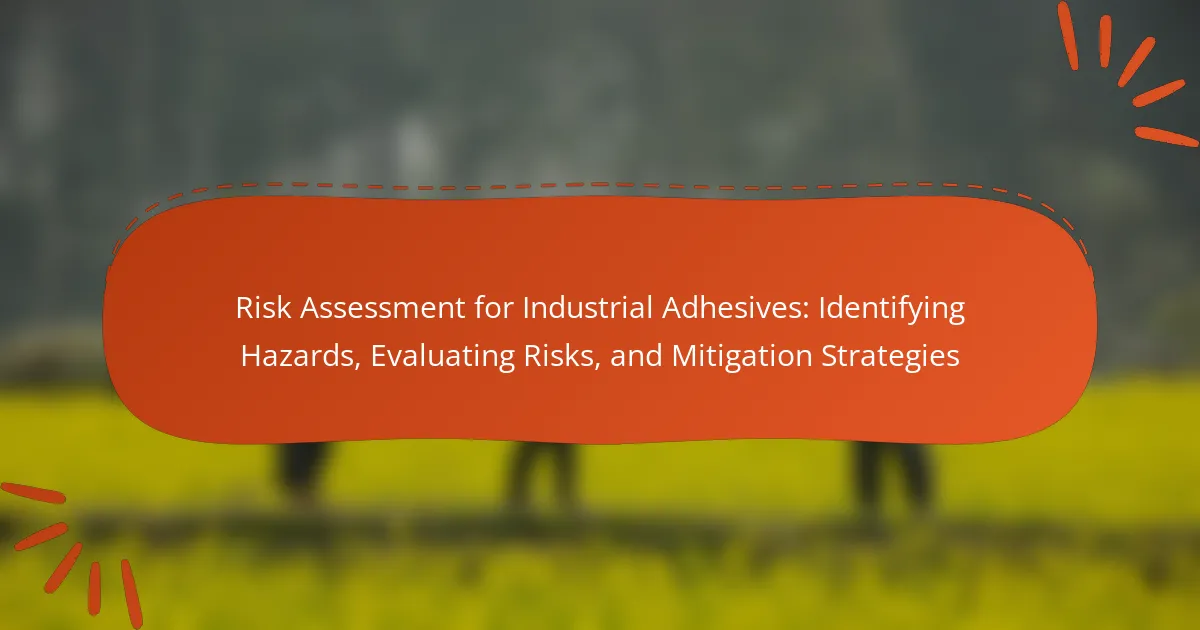Safety guidelines for industrial adhesives encompass proper storage, handling techniques, and the use of personal protective equipment (PPE) to mitigate risks associated with chemical exposure, flammability, and health hazards. Key practices include storing adhesives in a cool, dry environment, using appropriate PPE like gloves and goggles, and ensuring good ventilation in work areas. Companies must adhere to relevant regulations, maintain accurate Material Safety Data Sheets (MSDS), and conduct regular safety audits to ensure compliance. Understanding and implementing these guidelines is crucial for promoting workplace safety and minimizing potential hazards related to industrial adhesives.

What are the safety guidelines for industrial adhesives?
Safety guidelines for industrial adhesives include proper storage, handling techniques, and the use of personal protective equipment (PPE). Store adhesives in a cool, dry place away from direct sunlight. Ensure containers are tightly sealed to prevent contamination and evaporation. Use appropriate PPE such as gloves, goggles, and respirators to minimize exposure. Follow the manufacturer’s instructions for application and disposal. Maintain good ventilation in work areas to reduce inhalation risks. Regularly inspect storage areas for leaks or spills. Adhere to local regulations regarding hazardous materials. These practices help ensure safety and compliance in the use of industrial adhesives.
Why is proper storage important for industrial adhesives?
Proper storage is crucial for industrial adhesives to maintain their effectiveness and safety. Improper storage can lead to degradation of the adhesive properties. Factors such as temperature, humidity, and light exposure can negatively impact the adhesive’s performance. For example, high temperatures can cause premature curing or hardening. Humidity can lead to moisture absorption, which compromises adhesion quality. Additionally, exposure to light can cause chemical breakdown in certain adhesives. Proper storage ensures that the adhesives remain usable for their intended lifespan. According to manufacturers, following storage guidelines can extend shelf life by several months or even years.
What are the recommended storage conditions for industrial adhesives?
Industrial adhesives should be stored in a cool, dry place away from direct sunlight. The ideal temperature range for storage is typically between 50°F and 80°F (10°C to 27°C). Humidity levels should be kept low to prevent degradation. Containers must be tightly sealed to avoid exposure to air and moisture. Additionally, adhesives should be stored upright to prevent leaks. Always follow the manufacturer’s specific storage instructions for optimal performance. These guidelines help maintain the adhesive’s effectiveness and shelf life.
How can improper storage affect the performance of industrial adhesives?
Improper storage can significantly degrade the performance of industrial adhesives. Exposure to extreme temperatures can alter the chemical composition of adhesives. High humidity levels can lead to moisture contamination, affecting adhesion properties. UV light can cause degradation of certain adhesive formulations. Additionally, storing adhesives in unsealed containers can introduce contaminants. These factors can result in reduced bond strength and compromised durability. Studies show that adhesives stored at optimal conditions maintain their effectiveness longer. Proper storage is essential for ensuring reliability and performance in industrial applications.
What handling techniques should be followed when using industrial adhesives?
When using industrial adhesives, proper handling techniques are essential for safety and effectiveness. Always read the manufacturer’s instructions before use. Ensure the workspace is well-ventilated to minimize inhalation risks. Use appropriate personal protective equipment, such as gloves and goggles, to prevent skin and eye contact. Store adhesives at recommended temperatures to maintain their effectiveness. Avoid mixing different adhesive types unless specified by the manufacturer. Dispose of any waste materials according to local regulations to prevent environmental contamination. Regularly inspect adhesive containers for leaks or damage to ensure safe storage. Following these techniques minimizes risks associated with industrial adhesive use.
What are the key steps in safe handling of industrial adhesives?
The key steps in safe handling of industrial adhesives include proper training, use of personal protective equipment (PPE), and following manufacturer instructions. Workers should receive training on the hazards associated with specific adhesives. PPE such as gloves, goggles, and respirators should be worn to minimize exposure. Adhesives should be stored in a cool, dry place away from incompatible materials. Work areas must be well-ventilated to reduce inhalation risks. Spills should be cleaned immediately using appropriate materials. Waste should be disposed of according to local regulations. Regular safety audits should ensure compliance with handling procedures. These steps help prevent accidents and ensure a safe working environment.
How can one minimize risks during the application of industrial adhesives?
To minimize risks during the application of industrial adhesives, follow established safety protocols. Use appropriate personal protective equipment (PPE) such as gloves, goggles, and masks. Ensure proper ventilation in the workspace to reduce inhalation of fumes. Store adhesives according to manufacturer guidelines to prevent degradation. Conduct a risk assessment to identify potential hazards before starting the application. Train personnel on safe handling techniques to mitigate accidents. Regularly inspect equipment and work areas for safety compliance. Maintaining these practices can significantly reduce the likelihood of accidents and health issues.
What role does personal protective equipment (PPE) play in industrial adhesive safety?
Personal protective equipment (PPE) is essential for ensuring safety when handling industrial adhesives. PPE protects workers from exposure to hazardous chemicals found in adhesives. This includes gloves, goggles, and respirators tailored to specific adhesive formulations. Gloves prevent skin contact with irritants or toxic substances. Goggles shield the eyes from splashes or airborne particles. Respirators filter harmful fumes, ensuring safe inhalation levels. The use of PPE significantly reduces the risk of health issues, such as skin irritation or respiratory problems. Compliance with PPE guidelines is mandated by safety regulations in many industries. Proper training on PPE usage further enhances worker safety in adhesive handling.
What types of PPE are recommended when working with industrial adhesives?
Personal protective equipment (PPE) recommended when working with industrial adhesives includes gloves, goggles, and respirators. Gloves protect the skin from chemical exposure. Goggles shield the eyes from splashes and fumes. Respirators prevent inhalation of harmful vapors and dust. These PPE items are essential to minimize health risks associated with adhesive chemicals. According to the Occupational Safety and Health Administration (OSHA), proper PPE reduces the likelihood of injuries and illnesses in the workplace.
How does PPE mitigate risks associated with industrial adhesives?
PPE mitigates risks associated with industrial adhesives by providing a barrier between the user and hazardous substances. It includes gloves, goggles, respirators, and protective clothing. Gloves prevent skin contact with adhesives, which can cause irritation or allergic reactions. Goggles protect the eyes from splashes and fumes that may arise during application. Respirators filter harmful vapors and dust, ensuring safe inhalation levels. Protective clothing covers the skin, minimizing exposure to potentially harmful chemicals. Studies show that proper use of PPE reduces injury rates in industrial settings by up to 40%. Adhering to PPE guidelines ensures a safer work environment when handling industrial adhesives.

How can one ensure compliance with safety regulations for industrial adhesives?
To ensure compliance with safety regulations for industrial adhesives, companies must adhere to specific guidelines. First, they should familiarize themselves with the relevant regulations, such as OSHA standards and local environmental laws. Regular training sessions for employees on safe handling and storage practices are essential. Companies must also maintain accurate Material Safety Data Sheets (MSDS) for all adhesives used. Proper labeling of containers is crucial to inform workers of hazards. Additionally, conducting routine safety audits can help identify compliance gaps. Finally, implementing a clear incident reporting system will facilitate timely responses to safety issues. These measures collectively promote adherence to safety regulations in the use of industrial adhesives.
What are the legal requirements for the storage and handling of industrial adhesives?
The legal requirements for the storage and handling of industrial adhesives include compliance with OSHA regulations and local environmental laws. OSHA mandates that adhesives must be stored in a cool, dry place away from direct sunlight. Containers should be labeled clearly with hazard warnings. Additionally, safety data sheets (SDS) must be accessible to all employees handling these materials. Local environmental regulations may require specific waste disposal methods for adhesive residues. Regular training on safe handling practices is also necessary to ensure employee safety. Compliance with these requirements minimizes risks associated with flammable and toxic substances.
What regulations govern the use of industrial adhesives in different industries?
Regulations governing the use of industrial adhesives vary by industry. The Occupational Safety and Health Administration (OSHA) sets standards for workplace safety, including adhesive handling. The Environmental Protection Agency (EPA) regulates emissions and disposal of hazardous substances, including certain adhesives. The American National Standards Institute (ANSI) provides guidelines for safe adhesive application in construction. Additionally, industry-specific regulations, such as those from the Food and Drug Administration (FDA) for food packaging adhesives, exist. Compliance with Material Safety Data Sheets (MSDS) is required for proper handling and safety information. These regulations ensure safe usage and minimize health risks associated with industrial adhesives.
How can companies stay updated on safety regulations for industrial adhesives?
Companies can stay updated on safety regulations for industrial adhesives by regularly consulting official regulatory bodies. These include the Occupational Safety and Health Administration (OSHA) and the Environmental Protection Agency (EPA). Subscribing to newsletters from these organizations provides timely updates. Additionally, companies should attend industry conferences and workshops focused on adhesive safety. Networking with industry peers can also provide insights into best practices and regulatory changes. Utilizing online databases and resources dedicated to chemical safety is another effective strategy. Regularly reviewing safety data sheets (SDS) for specific adhesives ensures compliance with current regulations. Keeping abreast of changes in local, state, and federal laws is essential for maintaining safety standards.
What are the best practices for training employees on adhesive safety?
Best practices for training employees on adhesive safety include comprehensive education on hazards. Training should cover the specific types of adhesives used in the workplace. Employees must understand the potential risks associated with these adhesives. Instruction should include proper handling techniques to minimize exposure. Personal protective equipment (PPE) requirements must be clearly outlined. Regular refresher courses should be scheduled to reinforce safety practices. Employees should be trained in emergency response procedures for adhesive-related incidents. Hands-on training sessions can enhance retention and understanding of safety protocols.
How can effective training programs enhance safety when using industrial adhesives?
Effective training programs enhance safety when using industrial adhesives by educating workers on proper handling techniques. These programs teach the correct use of personal protective equipment (PPE). Workers learn about the hazards associated with different adhesives. They understand the importance of following safety data sheets (SDS) for each product. Training also includes emergency response procedures for spills or accidents. Research shows that companies with comprehensive training programs report fewer incidents. For example, OSHA states that effective training reduces workplace injuries by up to 30%. Enhanced knowledge leads to safer work practices and a culture of safety.
What topics should be covered in adhesive safety training sessions?
Adhesive safety training sessions should cover proper storage, handling techniques, and personal protective equipment. Proper storage includes guidelines on temperature control and avoiding incompatible materials. Handling techniques should emphasize safe application methods and minimizing exposure to fumes. Personal protective equipment training should detail the use of gloves, goggles, and respirators. Additionally, sessions should include emergency procedures for spills and exposure. Training should also address the importance of Safety Data Sheets (SDS) for understanding adhesive hazards. Regular updates on safety regulations and best practices are essential for compliance and safety awareness.

What are the common hazards associated with industrial adhesives?
Common hazards associated with industrial adhesives include chemical exposure, flammability, and health risks. Chemical exposure can occur through inhalation, skin contact, or ingestion. Many adhesives contain volatile organic compounds (VOCs) that can lead to respiratory issues. Flammability is a concern as some adhesives are highly combustible. This can result in fires or explosions if not handled properly. Health risks may include skin irritation, allergic reactions, or long-term health effects from chronic exposure. Safety Data Sheets (SDS) for adhesives provide detailed information on these hazards and necessary precautions.
What health risks are posed by exposure to industrial adhesives?
Exposure to industrial adhesives poses several health risks. These risks include respiratory issues, skin irritation, and potential long-term effects such as neurological damage. Inhalation of fumes can lead to symptoms like headaches, dizziness, and respiratory distress. Skin contact may cause dermatitis or allergic reactions. Some adhesives contain volatile organic compounds (VOCs) that can contribute to air quality issues and long-term health effects. Studies have shown that chronic exposure may increase the risk of certain cancers. Proper ventilation and personal protective equipment are essential to mitigate these risks.
What symptoms indicate potential overexposure to industrial adhesives?
Symptoms indicating potential overexposure to industrial adhesives include headaches, dizziness, and respiratory issues. These symptoms often arise due to inhalation of fumes emitted by adhesives. Skin irritation and allergic reactions may also occur. Users may experience eye irritation or tearing from contact with adhesive vapors. Nausea or vomiting can be signs of significant exposure. Fatigue or confusion may indicate neurological effects from prolonged exposure. Monitoring these symptoms is crucial for safety in industrial settings.
How can one identify hazardous chemicals in industrial adhesives?
One can identify hazardous chemicals in industrial adhesives by reviewing Safety Data Sheets (SDS). SDS provide detailed information about the chemical composition and hazards of the adhesive. They include sections on toxicity, flammability, and environmental impact. Additionally, labels on adhesive containers often indicate hazardous components. Regulatory agencies, such as OSHA and EPA, set standards for hazardous materials. Testing for volatile organic compounds (VOCs) can also reveal harmful chemicals. Identifying these hazards is crucial for safe handling and storage.
What environmental considerations should be taken into account with industrial adhesives?
Industrial adhesives can impact the environment through volatile organic compounds (VOCs) emissions. These emissions contribute to air pollution and respiratory problems. Proper disposal of adhesive containers is crucial to prevent soil and water contamination. Some adhesives contain hazardous materials that require special handling to avoid environmental harm. Biodegradable adhesives are preferable for reducing long-term ecological impact. Regulatory compliance with environmental laws is essential for manufacturers. The use of eco-friendly alternatives can minimize negative environmental effects. Overall, selecting adhesives with lower environmental footprints is a key consideration.
How can industrial adhesives impact the workplace environment?
Industrial adhesives can significantly impact the workplace environment through their chemical properties and usage. Many industrial adhesives contain volatile organic compounds (VOCs) that can contribute to poor indoor air quality. Prolonged exposure to these VOCs may lead to respiratory issues among workers. Additionally, improper handling of adhesives can result in spills, creating slip hazards on the workplace floor.
Furthermore, industrial adhesives may release harmful fumes during application or curing processes. This necessitates proper ventilation to mitigate health risks. Safety data sheets (SDS) for each adhesive provide crucial information on handling and potential hazards. Compliance with these guidelines can minimize negative impacts on the workplace environment.
Moreover, the disposal of unused or expired adhesives poses environmental concerns. Many adhesives are classified as hazardous waste, requiring specific disposal methods to prevent contamination. Adhering to safety regulations and guidelines can ensure a safer workplace environment for all employees.
What measures can be implemented to reduce environmental risks?
Implementing measures to reduce environmental risks includes proper storage of industrial adhesives. Storing adhesives in a cool, dry place minimizes the release of volatile organic compounds. Using sealed containers prevents spills and leaks. Regularly inspecting storage areas ensures that any potential hazards are addressed promptly. Training employees on safe handling techniques reduces the likelihood of accidents. Utilizing personal protective equipment protects workers and minimizes environmental contamination. Adopting eco-friendly adhesive alternatives can also significantly lower environmental impact. These measures collectively contribute to a safer and more sustainable industrial environment.
What practical tips can enhance safety when working with industrial adhesives?
Use appropriate personal protective equipment (PPE) to enhance safety when working with industrial adhesives. This includes gloves, goggles, and masks to protect against skin contact, eye exposure, and inhalation of fumes. Ensure adequate ventilation in the workspace to minimize inhalation risks. Always read and follow safety data sheets (SDS) for specific adhesives to understand their hazards. Store adhesives in a cool, dry place away from direct sunlight and incompatible materials to prevent accidents. Use only in well-ventilated areas or with appropriate respiratory protection when necessary. Dispose of any adhesive waste according to local regulations to avoid environmental hazards. Regularly inspect tools and equipment for damage to prevent leaks or spills during use.
The main entity of this article is industrial adhesives, which require specific safety guidelines for their effective use. Key topics include proper storage conditions that maintain adhesive effectiveness, essential handling techniques to minimize health risks, and the importance of personal protective equipment (PPE) to safeguard workers from chemical exposure. The article outlines best practices for compliance with safety regulations, the potential hazards associated with industrial adhesives, and the environmental considerations necessary for safe usage. Overall, it emphasizes the critical need for training and adherence to established safety protocols to ensure a safe working environment when using industrial adhesives.



